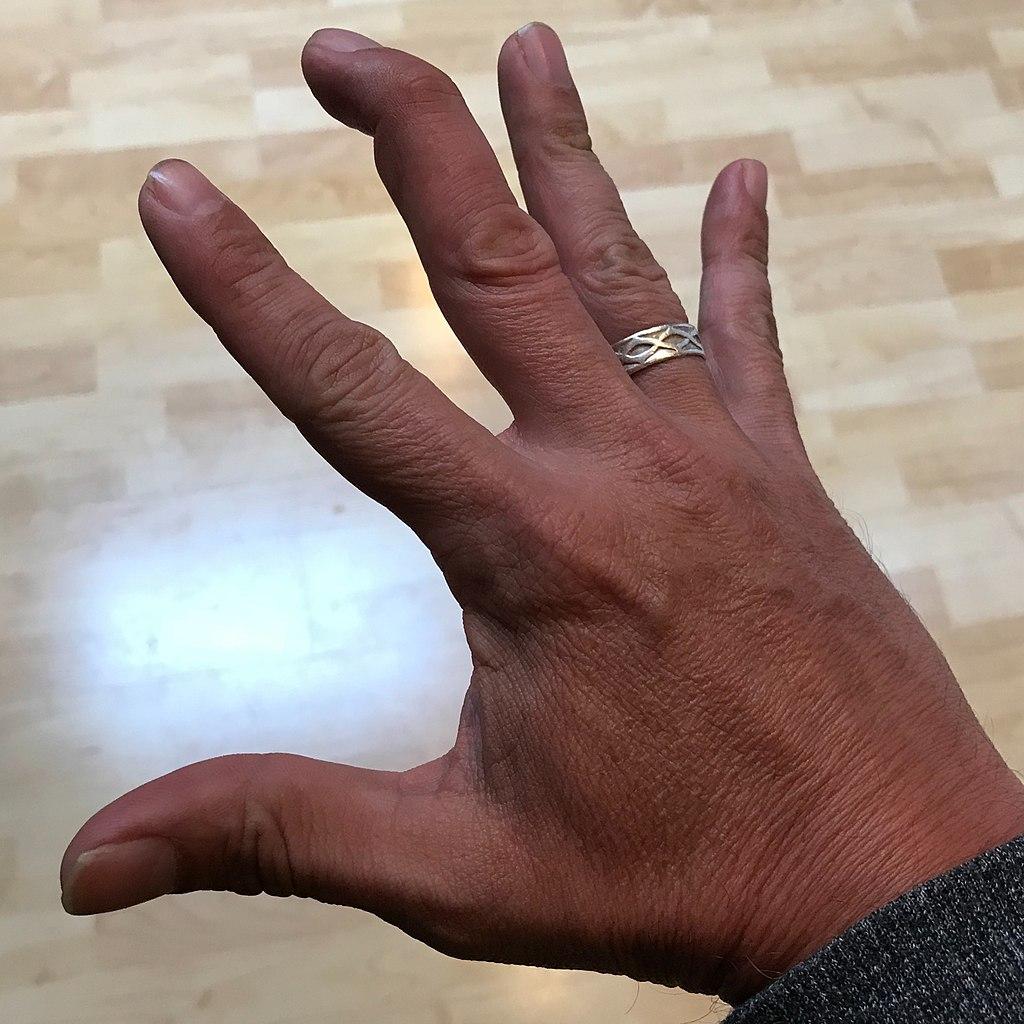Mallet finger
Peer reviewed by Dr Colin Tidy, MRCGPLast updated by Dr Hayley Willacy, FRCGP Last updated 15 Sept 2024
Meets Patient’s editorial guidelines
- DownloadDownload
- Share
- Language
- Discussion
A finger that bends down at the end joint and cannot be straightened is called a mallet finger. It is caused by an injury to the tendon that straightens (extends) the finger. A splint worn day and night for 6-8 weeks will cure the problem in most cases.
In this article:
Continue reading below
What is a mallet finger?
A mallet finger describes a condition in which the end of a finger is bent (flexed) towards the palm and cannot straighten.
What causes a mallet finger?
The usual cause is an injury to the end of the finger. The injury tears the tendon that straightens (extends) the end of the finger.
It is sometimes called baseball finger, as it is a common injury when trying to catch a fast, hard ball. If the catch is missed slightly then the ball hits the straight finger. This may force the end of the finger to bend (flex) further than normal and tear the tendon. Without the use of this tendon, the finger stays bent (flexed).
Diagram of the hand showing mallet finger

Sports injuries are a common cause of mallet finger. However, any injury that forces the end joint of a finger to over-bend can cause it. (Sometimes the tendon does not tear but the injury causes a piece of bone to be pulled off the finger where the tendon is attached. This is called an avulsion fracture. The result is the same, as the tendon then cannot pull on the bone.)
Continue reading below
What are the symptoms of a mallet finger?
After the injury, the end of your finger may:
Be painful and swollen.
Lie in a bent (flexed) position.
Not be able to straighten (extend) at the end.
Mallet finger

Clappstar, CC BY-SA 4.0, via Wikimedia Commons
How is mallet finger diagnosed?
The clinician can usually diagnose a mallet finger from listening to how the injury occurred and how the finger looks and feels when examined. If there is any doubt they may request an x-ray.
Continue reading below
What is the treatment for mallet finger?
Splint
A splint is worn for 6-8 weeks to keep the finger straight with the end joint bent backwards slightly (overextended). It must be worn all the time, day and night.
There are many different types of splints available. The type of splint given often depends on the size and shape of your finger. You must not take the splint off at any time during this treatment. If you have to take it off (for example, to wash) then you must keep that finger straight and not allow it to bend (flex).
Keeping the finger straight constantly allows the two ends of the torn tendon or bone to stay together and heal. About three in four cases heal well with this treatment.
Surgery
Surgery is needed to repair the torn tendon if the above fails. (Surgery may be advised straightaway if there is a cut to your finger; however, most injuries that cause mallet finger do not cut the skin.)
Recovering from mallet finger
It may take several months for your finger to fully recover its function. Any redness, swelling and tenderness of your skin over the end of your finger may persist for the first few months after the injury. These symptoms will usually improve eventually.
Can mallet finger be prevented?
As most mallet finger injuries occur during sports, taking care when playing with a hard ball is advisable but prevention may not always be possible. You can prevent the deformity returning by using the splint exactly as directed by your clinician.
Patient picks for Joint problems
%2Fog.png&w=1600&q=75)
Bones, joints and muscles
Temporomandibular Joint Disorder (TMD)
Temporomandibular disorders are problems affecting the jaw joint and the muscles and other tissues around the jaw joint. These disorders usually cause pain or reduced movement of the jaw, and sometimes sounds such as clicking or grating of the jaw joint. There are various causes but generally temporomandibular disorders are not serious and often improve with simple treatments.
by Dr Rosalyn Adleman, MRCGP

Bones, joints and muscles
Greater trochanteric pain syndrome
Greater trochanteric pain syndrome is a condition that causes pain over the outside of the upper thigh (or both thighs) and hip. The cause is usually due to inflammation or injury to some of the tissues that lie over the bony prominence (the greater trochanter) at the top of the thigh bone (femur). Greater trochanteric pain syndrome can sometimes cause significant pain and also difficulty with walking. The pain is usually caused by injury, prolonged pressure or repetitive movements. Runners or people who have had surgery to their hip can have this type of pain.
by Dr Philippa Vincent, MRCGP
Further reading and references
- Yee J, Waseem M; Mallet Finger Injuries.
- Handoll HH, Vaghela MV; Interventions for treating mallet finger injuries. Cochrane Database Syst Rev. 2004;(3):CD004574.
- Salazar Botero S, Hidalgo Diaz JJ, Benaida A, et al; Review of Acute Traumatic Closed Mallet Finger Injuries in Adults. Arch Plast Surg. 2016 Mar;43(2):134-44. doi: 10.5999/aps.2016.43.2.134. Epub 2016 Mar 18.
Continue reading below
Article history
The information on this page is written and peer reviewed by qualified clinicians.
Next review due: 14 Sept 2027
15 Sept 2024 | Latest version

Ask, share, connect.
Browse discussions, ask questions, and share experiences across hundreds of health topics.

Feeling unwell?
Assess your symptoms online for free
Sign up to the Patient newsletter
Your weekly dose of clear, trustworthy health advice - written to help you feel informed, confident and in control.
By subscribing you accept our Privacy Policy. You can unsubscribe at any time. We never sell your data.